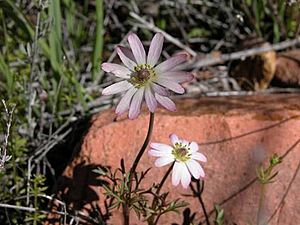Desert anemone facts for kids
Quick facts for kids Desert anemone |
|
|---|---|
 |
|
| Scientific classification | |
| Genus: |
Anemone
|
| Species: |
tuberosa
|
The Anemone tuberosa, also known as the desert anemone or tuber anemone, is a cool plant that grows in the deserts and rocky areas of North America. It's a type of herbaceous plant, which means it has soft stems instead of woody ones. This plant belongs to the Ranunculaceae family, which includes buttercups. This unique flower gets its name from the special woody-like tuber it grows from, which helps it survive in tough environments.
Contents
Meet the Desert Anemone
What Does the Desert Anemone Look Like?
The desert anemone usually grows to be about 10 to 30 centimeters tall. Sometimes it can even reach 40 centimeters. That's about the height of a ruler or a bit taller! It grows from a special underground part called a caudex. This caudex is like a thick, woody base that stores energy for the plant.
This plant has a few leaves near its base. These leaves are often deeply divided into three parts. They usually have long stems.
Flowers and Fruits
The desert anemone blooms in the spring, from early to late spring. Its flowers are very pretty. Each flower has 8 to 10 sepals. Sepals are like petals, but they are usually greener and protect the flower bud. For the desert anemone, these sepals are normally white or pink. They are about 10 to 14 millimeters long.
The plant can have one flower on a single stem. Or it can have a cluster of 2 to 5 flowers. After the flowers fade, the plant produces fruits. These fruits are called achenes. They are small, about 2.5 to 3.5 millimeters long. They are flat and covered in dense, woolly hairs. Each achene has a small, straight beak.
Where Does the Desert Anemone Grow?
The Anemone tuberosa is native to parts of North America. You can find it mostly in the southwestern and central United States. This includes states like Nevada, New Mexico, California, and Texas. It also grows in northern Mexico.
This spring-flowering plant loves rocky slopes. It also grows along stream banks. It prefers places where the ground is a bit rough and stony.
Part of a Bigger Family
The desert anemone is part of a larger group of similar plants. This group includes about 6 to 9 different species. These species are native to the southwestern and central USA. They also extend all the way down to South America. Most of these related plants also grow from tubers or caudex-like tubers. This special root system helps them store water and nutrients. It allows them to survive in dry or challenging environments.

